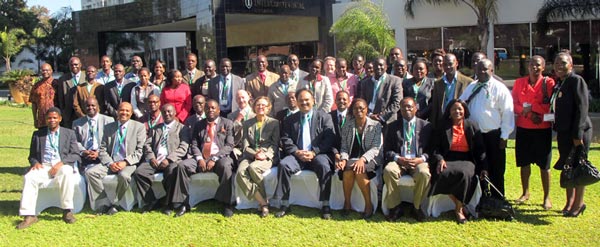A Launch and Inception Planning Workshop for the Effective Grain Storage for Sustainable Livelihoods of African Farmers (EGSP) Phase-II Project was held in Lusaka, Zambia, during 28-29 June 2012. Building on the successes of the previous phase (2008-2011), EGSP-II (2012-2016) aims to improve food security and reduce vulnerability of resource-poor farmers, particularly women farmers, in eastern and southern Africa, through the dissemination of effective grain storage technologies, especially metal silos and super grain bags.
Current regional post-harvest grain losses are estimated at USD 4 billion annually, according to project coordinator, Tadele Tefera. This is equivalent to a decade of food aid for the region, or enough annual calories for about 48 million people. With the support of the Swiss Agency for Development and Cooperation (SDC), phase I implemented the project in Kenya and Malawi, and its activities will now be extended to Zambia and Zimbabwe in phase II. Use of similar technologies in Latin America has significantly reduced post-harvest losses in the region. For this reason, EGSP-II “should go a long way in reducing post-harvest losses,” said Elizabeth Diethelm-Schneller, SDC deputy director for Southern Africa. B.M. Prasanna, director of the CIMMYT Global Maize Program, noted that the metal silo is one of the most effective technologies against some of the most destructive post-harvest pests, such as the large grain borer and the maize weevil.
The meeting allowed CIMMYT scientists, partners, and collaborators in the Southern African Development Community (SADC) to exchange ideas, information, and research outputs on the effective grain storage project; raise awareness on promotion and dissemination of effective grain storage technologies in SADC; and consult stakeholders on effective post-harvest technology, policy environment, and market issues, for the purpose of refining, updating, and implementing EGSP-II. Bekele Shiferaw, director of the CIMMYT Socioeconomics Program, called for a holistic approach in the project implementation. “Enabling policy environment and market linkages have a strong bearing on investments in post-harvest handling,” said Shiferaw. “Reliable markets that allow capturing of benefits from quality and seasonal price gains enable storage investments,” he added.
Presiding over the launch on behalf of Emmanuel Chenda, Honorable Minister of Agriculture and Livestock, Republic of Zambia, Deputy Minister Rodgers Mwewa noted that the project could not have come at a better time for the region. The benefit of bumper harvests has been negated by insufficient storage capacity and resulting post-harvest losses. “Due to a lack of awareness and access to appropriate technologies, farmers end up selling their maize soon after harvest, when prices are at their lowest, partly to curb the loss to post-harvest pests and partly to meet other financial needs. The same farmers are forced to buy the grains back at more than twice the price later in the season, resulting in a continual poverty trap,” added Chenda, in a speech read on his behalf by his deputy.
Maize provides food and income to over 300 million resource-poor smallholders in eastern and southern Africa. Therefore, postharvest losses fuel food insecurity and impoverishment. “We have to find lasting solutions to postharvest losses,” said Chenda. “The potential impact of increased maize productivity on poverty reduction and greater livelihood security will not be realized unless technological and institutional innovations are identified and deployed to overcome the chronic syndrome of ‘sell low and buy high,’” he concluded.

 Innovations
Innovations 
